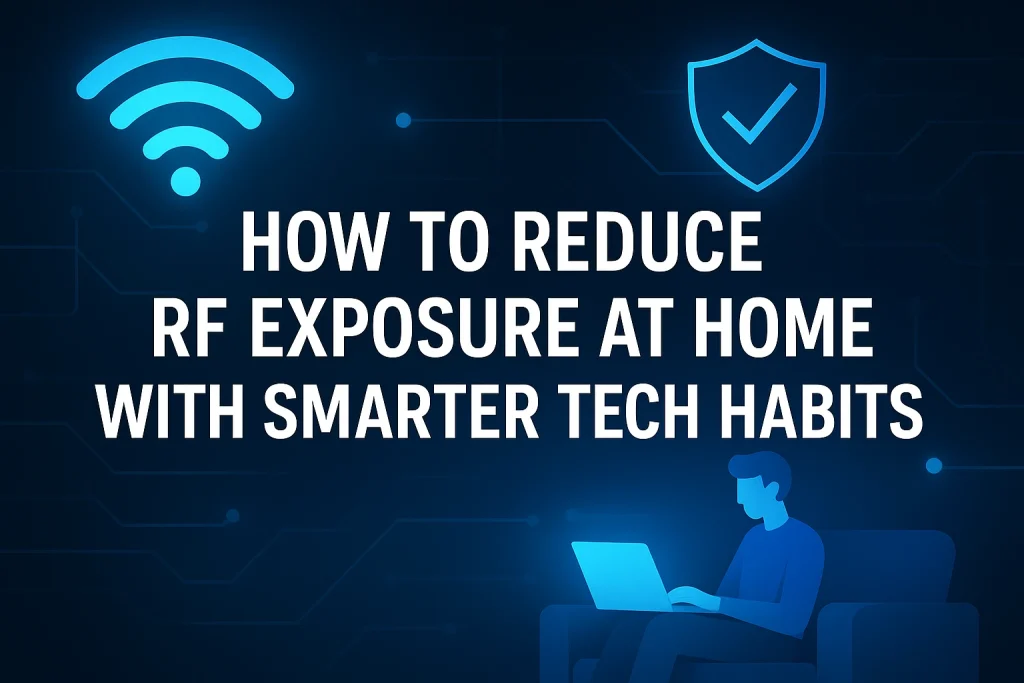In today’s world, our homes are filled with smart devices, wireless gadgets, and internet-connected appliances. While this technology makes life more convenient, it also exposes us to radio frequency (RF) radiation from Wi-Fi routers, smartphones, smart TVs, tablets, and even wearable tech. Many people are now asking the important question: how can we enjoy modern technology without unnecessary RF exposure?
This blog explores how to reduce RF exposure at home with smarter tech habits—practical, achievable steps that protect your well-being while keeping your lifestyle modern and connected.
Understanding RF Exposure
RF exposure comes from radiofrequency electromagnetic fields (EMFs), a type of non-ionizing radiation used to transmit data wirelessly. Unlike X-rays or gamma rays, RF waves don’t have enough energy to break DNA directly. However, prolonged exposure is a growing concern for some health experts due to potential biological effects, particularly with the constant use of wireless devices.
Common sources of RF radiation in the home include:
- Wi-Fi routers and mesh networks
- Smartphones, tablets, and laptops
- Smart home devices like voice assistants, cameras, and thermostats
- Bluetooth headphones, speakers, and wearables
- Microwave ovens (though usually shielded well)
While it’s almost impossible to eliminate RF radiation completely, you can reduce your exposure significantly with smarter daily habits.
Why Should You Care About Reducing RF Exposure?
Even though research on long-term health risks is ongoing, many people choose to take a precautionary approach. Here are a few reasons why it makes sense to be proactive:
- Better Sleep Quality – Constant EMFs can interfere with melatonin production, a hormone that regulates sleep.
- Reduced Stress Levels – Some people report headaches, fatigue, or brain fog when exposed to strong RF signals for extended periods.
- Children’s Health – Kids absorb more radiation due to thinner skulls and developing bodies.
- Peace of Mind – Taking steps now means you’re minimizing unnecessary risks, even if science hasn’t fully caught up.
Smarter Tech Habits to Reduce RF Exposure
Here are practical strategies to cut down on RF radiation at home without giving up modern conveniences.
1. Manage Your Wi-Fi Wisely
- Turn Off Wi-Fi at Night: Your body doesn’t need internet access while sleeping. Use a simple timer plug to automatically shut it off.
- Use Wired Connections When Possible: Ethernet cables are faster, more secure, and radiation-free. Consider connecting your desktop or TV directly to the router.
- Position Your Router Strategically: Keep routers away from bedrooms or high-use sitting areas. Distance reduces exposure dramatically.
2. Create Tech-Free Sleep Zones
- No Phones by the Bed: Use an old-fashioned alarm clock instead.
- Airplane Mode Overnight: If you need your phone nearby, switch it to airplane mode to cut off RF transmissions.
- Shielding Options: Some people use EMF shielding canopies or fabrics around their beds, though even small changes like distance help.
3. Rethink Smartphone Habits
- Use Speakerphone or Wired Headsets: This keeps the device away from your head.
- Text Instead of Calling: Sending quick messages reduces call-related exposure.
- Avoid Body Contact: Don’t carry your phone directly against your body—in a pocket or bra, for example. Use a bag or keep it on a table instead.
4. Smart Placement of Smart Devices
- Keep Smart Appliances at a Distance: Don’t install smart hubs, speakers, or Wi-Fi cameras in your bedroom.
- Disable Features You Don’t Use: Turn off Bluetooth, location services, or Wi-Fi scanning when unnecessary.
- Batch Device Use: Instead of having multiple devices always-on, manage when they’re active.
5. Embrace Wired Alternatives
- Wired Keyboards and Mice: Reduce constant Bluetooth exposure.
- Corded Headphones: Opt for classic wired earbuds over wireless ones.
- Landline Phones: Still practical for long home conversations.
6. Limit Kids’ Exposure
- Encourage Offline Play: Balance screen time with outdoor activities.
- Download Media First: Let kids watch videos offline rather than streaming.
- Child-Safe Zones: Make bedrooms and playrooms Wi-Fi-free when possible.
7. Minimize Bluetooth Use
Bluetooth devices constantly emit RF signals, even when not actively transferring data. Consider these swaps:
- Use a wired fitness tracker if possible, or sync your wearable once a day instead of continuously.
- Replace wireless speakers with wired connections when at home.
- Choose wired controllers for gaming consoles.
8. Turn Off What You Don’t Need
- Airplane Mode for Tablets: Kids often use tablets for games or reading—no need for Wi-Fi to be on.
- Smart TV Settings: Disable constant data-syncing features if you don’t use them.
- Home Office Check: Power down unused laptops, printers, or hotspots when not in use.
9. Use EMF-Friendly Home Design
- Router on a Timer: Automatically cut exposure during downtime.
- Bedrooms as Low-EMF Zones: No smart TVs, no routers, no wireless printers.
- Shielding Paint or Films: For people in high-exposure environments (like apartments near cell towers), shielding materials can add another layer of protection.
10. Adopt a “Distance First” Mindset
A simple rule: distance equals safety. Even moving a device a few feet away drastically lowers your exposure. For example:
- Sitting 6 feet from your Wi-Fi router instead of 2 feet can cut exposure significantly.
- Using your laptop on a desk instead of your lap reduces direct body contact.
- Watching movies on a TV screen instead of holding a phone close for hours helps limit RF absorption.
Practical Daily Routine for Lower RF Exposure
Here’s how an average day could look with smarter tech habits:
- Morning: Phone on airplane mode overnight, Wi-Fi turns on automatically at 7 AM via timer. You check messages after breakfast.
- Work Hours: Laptop connected with Ethernet cable. Phone on desk (not in pocket), Bluetooth off.
- Evening: Family movie downloaded beforehand to avoid streaming. Kids play board games before bed.
- Night: Wi-Fi router switches off automatically, all devices in airplane mode or powered down. Bedroom is a calm, tech-free zone.
By building small habits like these, you’ll naturally reduce RF exposure without sacrificing modern comforts.
Taking a Balanced Approach
It’s important to remember that technology itself isn’t “bad.” Smartphones, Wi-Fi, and smart home devices bring immense convenience and connectivity. The key is using them intentionally rather than letting them run constantly without thought.
Just like with diet or exercise, balance is everything. You don’t need to throw away all your wireless devices—you just need to manage them wisely.
Conclusion:-
Learning how to reduce RF exposure at home doesn’t mean living in the dark ages. It’s about making thoughtful choices: turning off Wi-Fi when not needed, placing routers away from bedrooms, choosing wired connections when possible, and encouraging screen-free time for children.
If you’re concerned about your household’s exposure levels, consider professional radio frequency EMF testing to get an accurate picture of your environment. That way, you can take targeted actions with peace of mind.
By adopting these smarter tech habits, you’ll create a healthier home environment while still enjoying the benefits of modern living.
Frequently Asked Questions:-
1. What are the main sources of RF exposure at home?
- The biggest sources include Wi-Fi routers, smartphones, tablets, smart TVs, Bluetooth devices, and smart home appliances such as speakers or cameras.
2. Does turning off Wi-Fi at night really make a difference?
- Yes. Since most people spend 6–8 hours sleeping, switching off your Wi-Fi router at night can significantly cut down your overall daily RF exposure.
3. Is it safer to use wired connections instead of wireless?
- Absolutely. Wired connections like Ethernet cables provide faster, more stable internet access without emitting radiofrequency radiation.
4. How can I reduce my child’s RF exposure?
- Encourage more offline activities, limit streaming by downloading videos in advance, and keep Wi-Fi routers and smart devices out of bedrooms or play areas.
5. Do I need professional testing to check RF levels at home?
- Not necessarily, but professional radio frequency EMF testing can give you a clearer understanding of your exposure and help you take more targeted actions.


